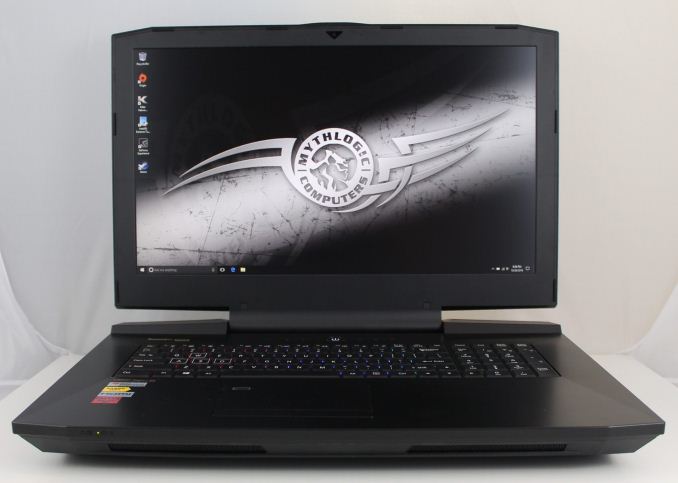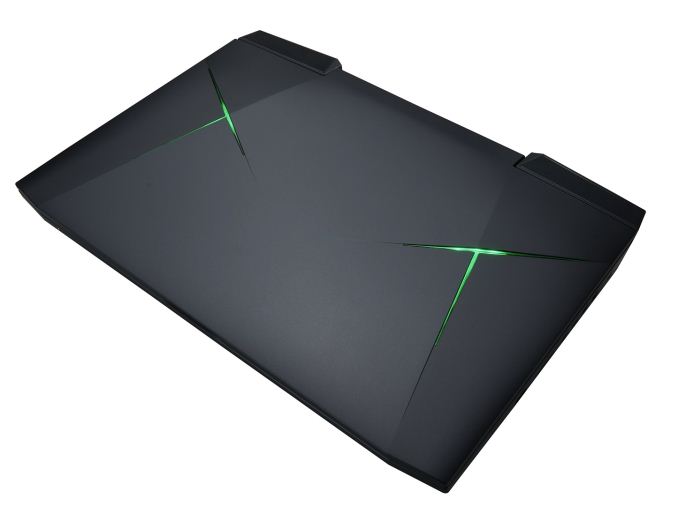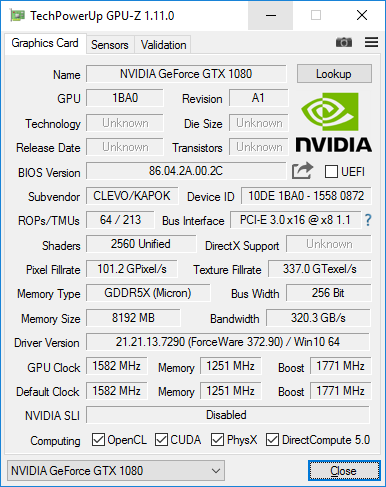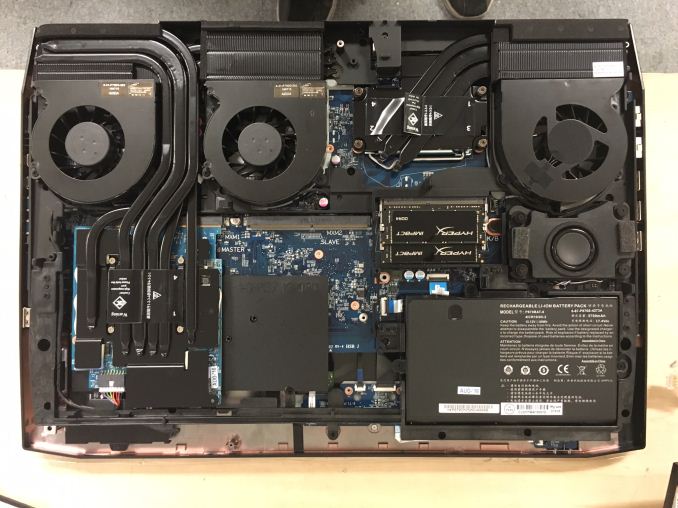The Clevo P870DM2 / Mythlogic Phobos 8716 Laptop Review: DTR With GTX 1080
by Brett Howse on October 27, 2016 2:00 PM EST
Sometimes there is no substitute for performance. Most of the laptop market is focusing on thin and light designs, with companies attempting to outdo each other by shaving a millimeter or two off of their laptop z-height compared to the competition. But in the Desktop Replacement (DTR) category, there are no such concessions. Clevo is one of the few laptop makers that is in the DTR market, and thanks to the assistance of Mythlogic, we have the Mythlogic Phobos 8716 DTR for review today. As a Clevo, the model would be P870DM2.
Let’s cut right to the chase. The Mythlogic Phobos 8716 is a beast of a laptop, and really should rarely be used in your lap. It is designed for someone who needs the ultimate performance, but still needs something more portable than a full desktop. This is a 17.3-inch display packed into a chassis that is 47.2 mm thick (1.86”) and weighs in at 5.5 kg (12.13 lbs) with a single GPU. And yes, you can opt for two GPUs, which ups the weight and moves you into the land of ridiculous.
Mythlogic offers a couple of choices of CPU and GPU, but all the CPUs are desktop parts, from the Intel Core i5-6400 65-Watt processor up to the Intel Core i7-6700K 91-Watt processor (as we have in the review unit). This is the same unlocked quad-core as you would find in any high performance desktop. On the GPU side, the base model is a mere GTX 1070, or step up to the GTX 1080, or either card in SLI. If you get dual GTX 1080 GPUs, be prepared to have two AC outlets handy for the dual 330-Watt AC Adapters. Mythlogic also supports overclocking on all of the components. There are four SODIMM slots for up to 64 GB of DDR4 memory as well. This is well and truly a desktop class computer packed into a (somewhat) portable chassis.
The display options also need mentioning too. The standard panel is a 1920x1080 IPS display with a 120 Hz refresh rate. That should be a very significant upgrade for almost anyone, up from the ubiquitous 60 Hz laptop displays. They are also offering a 2560x1440 AHVA 120 Hz panel with G-SYNC option, and a 3840x2160 60 Hz AVHA panel which also includes G-SYNC.
| Mythlogic Phobos 8716 / Clevo P870DM2 | |
| As Tested: 6700K, 16GB (2x8) 2400 DDR4, 1x1080, 256GB Samsung 950 Pro m.2, 120Hz FHD, $2980 USD |
|
| CPU | Intel Core i5-6400, 4C/4T, 2.7-3.3 GHz, 6MB Cache, 65W TDP |
| Intel Core i5-6500, 4C/4T, 3.2-3.6 GHz, 6MB Cache, 65W TDP | |
| Intel Core i5-6600, 4C/4T, 3.3-3.9 GHz, 6MB Cache, 65W TDP | |
| Intel Core i5-6600K, 4C/4T, 3.5-3.9 GHz, 6MB Cache, 91W TDP | |
| Intel Core i7-6700, 4C/8T, 3.4-4.0 GHz, 8MB Cache, 65W TDP | |
| Intel Core i7-6700k, 4C/8T, 4.0-4.2 GHz, 8MB Cache, 91W TDP | |
| GPU | NVIDIA GTX 1070 8GB, 2048 CUDA Cores , 1442 - 1645 (Boost) MHz Also available as 2 x SLI |
| NVIDIA GTX 1080 8GB, 2560 CUDA Cores, 1556 - 1733 (Boost) MHz Also available as 2 x SLI |
|
| Memory | 4 SODIMM Slots, 64 GB Max, up to 3000 MHz |
| Display | 17.3" 1920x1080 IPS 120Hz Optional 2560x1440 AHVA 120 Hz w/G-SYNC Optional 3840x2160 AHVA 100% Adobe RGB w/G-SYNC |
| Storage | 2 x 9.5mm 2.5” SATA 2 x m.2 Slot (SATA or 4xPCIE) |
| I/O | 5 x USB 3.0 Ports (1 x powered USB port, AC/DC) 2 x USB 3.1 / Thunderbolt 3 Port (Type-C) 1 x HDMI 2.0 output Port (with HDCP) 2 x DisplayPort 1.3 output Ports SD Card Slot 1 x Headphone Jack 1 x Microphone Jack 1 x Line-in Jack 1 x S/PDIF (digital) (Shared with headphone jack) 2 x Killer E2400 RJ-45 LAN (10/100/1000Mbps) |
| Dimensions | 428 x 308 x 47.2 mm 16.85 x 12.12 x 1.86 inches |
| Weight | 5.5 kg / 12.13 lbs (single GPU) |
| Battery | 82 Wh, 330W / 230W W AC Adapter |
| Wireless | Intel Dual Band Wireless-AC8260 2x2:2 with Bluetooth 4.1 Killer Wireless-AC 1535 2x2:2 with Bluetooth 4.1 |
| Price | $2255 - $5000+ |
There is no shortage of ports, with five USB 3.0 ports, two USB 3.1 Type-C ports with Thunderbolt 3, HDMI 2.0, two DisplayPort 1.3, and separate audio jacks for the headphone, microphone, and line-in. It also features a Killer E2400 Ethernet adapter, and that wired connection can be paired with either the Killer 1535-AC wireless to support Killer’s DoubleShot Pro, or Intel’s Dual Band Wireless-AC 8260 card if you prefer their solution.
With a starting price of $2255, the Mythlogic Phobos could never be considered inexpensive, but on the performance per dollar metric, there are few laptops that offer this kind of performance period, let alone for the price.













61 Comments
View All Comments
Drumsticks - Thursday, October 27, 2016 - link
The Surface AIO is not really a great choice for gaming. It's more a "Compete with Cintiq" type device, where they can get away with selling a 27" QHD touch+pen monitor for $2800.ZeDestructor - Thursday, October 27, 2016 - link
If the Surface AIO came in monitor-only form, I'd give it some pretty hefty consideration for use during onenote/collab sessions/RPG mapping and such.andychow - Thursday, October 27, 2016 - link
A 12 lbs laptop that has a battery life of one hour. Let's be real, you aren't moving this thing around. Just buy a desktop.RaichuPls - Thursday, October 27, 2016 - link
It could be useful as a product for somebody who moves around often, traveling a lot and using it in a hotel etc.Dribble - Thursday, October 27, 2016 - link
There's definitely a sliding scale of portability going from phone -> desktop. This sits between ultra book, and mini desktop pc. You're not going to use it on the train/plane, but it still fits in a laptop bag - you can take it too hotels, or even just take it on/off the kitchen table easily. While power isn't going to last on battery it will run for a while which is often enough.On the downside they are loud - anything 49 db new is going to get annoying loud when the fans clog up with dust. It's also hard to upgrade gpu's - you can upgrade memory and hd's easily enough, and these days the cpu is good for life but gpu's are still moving forward fast and you can end up with a laptop that is pretty current in everything but gpu performance after a few years.
ZeDestructor - Thursday, October 27, 2016 - link
At least you can upgrade the GPU, and by the looks of it, this has all the provisions to reliably feed 180W MXM-based modules for a long time too.TheinsanegamerN - Thursday, October 27, 2016 - link
assuming the BIOS can support newer GPUs, which is incredibly hit or miss.ZeDestructor - Friday, October 28, 2016 - link
Clevos are known to support it, by specifically not doing any UEFI/vBIOS level hackery. Basically just slaps the card in and routes out the extra DP connectors from the MXM slot to the physical ports and screen. Very desktop-style.bji - Thursday, October 27, 2016 - link
It would make a fine portable VR rig for those with lots of money to burn. I built a portable ITX system for about half the cost of the laptop, but there is no doubt that the laptop is even more portable and certainly much slicker with its built-in display, keyboard, and pointing solution (which are all separate components in my ITX build obviously).Only problem is that you can upgrade the ITX system with a new graphics card, but with the laptop, the graphics card you get is the only one you'll ever have.
doggghouse - Thursday, October 27, 2016 - link
Actually, one of Mythlogic's features is their Lifetime Phoenix Upgrade Plan, which lets you send your laptop back to them and upgrade whatever hardware you want. Assuming they are using some fairly standard components (Clevo?), you could in theory take your laptop with a GTX 780M card and upgrade it to GTX 1080 (or even go with a Radeon?!). I haven't seen reviews of how well it works, but I really like the concept. I personally have an Alienware laptop from 2011, and have seen people use some BIOS hacks to make newer GPUs work, since Dell sells some of those parts directly. I imagine if the company actually supported it, the concept would work even better!